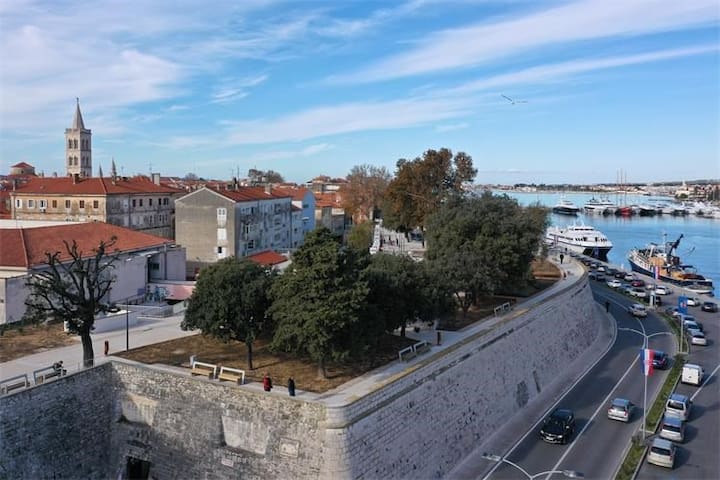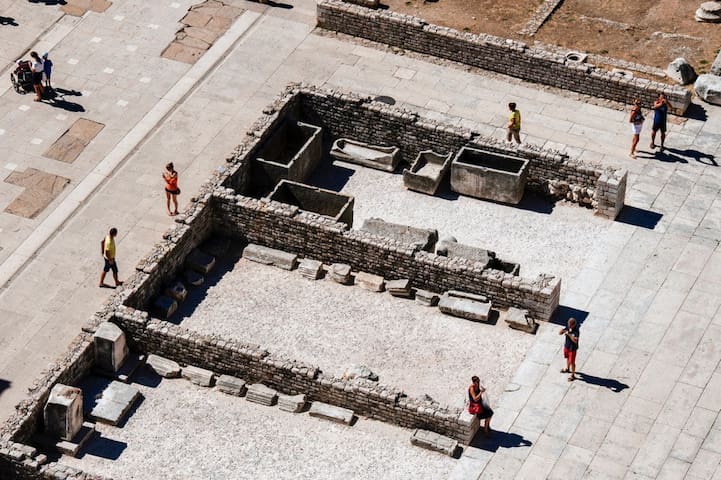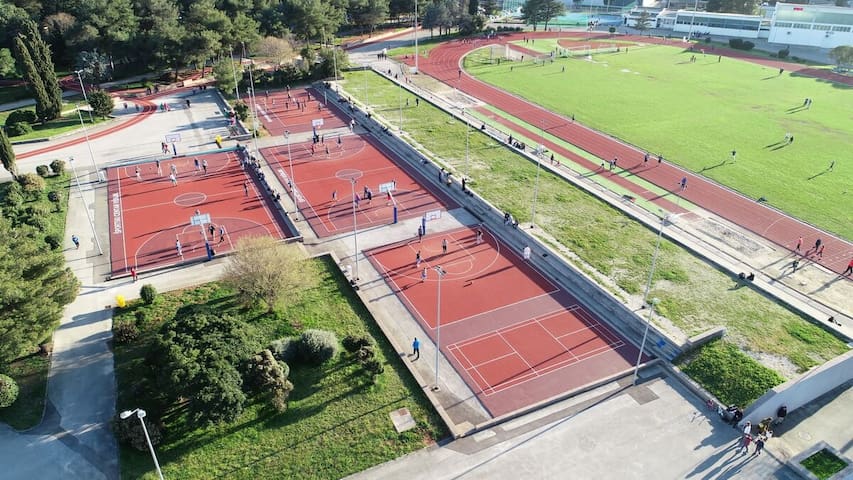Food scene
Great food and location is in the city center. If you decide to go here, try bruschetta’s 😊
Reservations are usually required!
413 íbúar mæla með
Restoran Bruschetta
12 Ul. Mihovila PavlinovićaGreat food and location is in the city center. If you decide to go here, try bruschetta’s 😊
Reservations are usually required!
Location inside the heart of the city. Excellent price/quality balance. They offer traditional dalmatian food with a modern twist . My personal favorite!
40 íbúar mæla með
Proto Food&More
1 Stratico ul.Location inside the heart of the city. Excellent price/quality balance. They offer traditional dalmatian food with a modern twist . My personal favorite!
Foša
2 Ul. kralja Dmitra ZvonimiraGreat fish restaurant! Check the prices online, they can be spicy!
Burgers & more
36 Ulica Antuna Gustava MatošaBest burgers in town, also available on Glovo.
Sightseeing
Also on Zadar's southwestern quay, the celebrated Sea Organ is an urban installation and a musical instrument. Tubing within the stone steps transforms the movement of the waves and the sea breezes into a series of haunting chords. It makes the perfect accompaniment to the sunset.
659 íbúar mæla með
Sjávarorgel
Obala kralja Petra Krešimira IVAlso on Zadar's southwestern quay, the celebrated Sea Organ is an urban installation and a musical instrument. Tubing within the stone steps transforms the movement of the waves and the sea breezes into a series of haunting chords. It makes the perfect accompaniment to the sunset.
The walls were built in the 12th and 13th centuries, and reinforced in the 16th century for the purpose of the Venetian defence against Turkish conquerors. The city walls got their official name "Walls of Zadar Uprisings" after the eleven uprisings of Zadar citizens against the Venetian Republic authorities.
Beautiful place for the evening walk above the city.
7 íbúar mæla með
Bedemi zadarskih pobuna
Bedemi zadarskih pobunaThe walls were built in the 12th and 13th centuries, and reinforced in the 16th century for the purpose of the Venetian defence against Turkish conquerors. The city walls got their official name "Walls of Zadar Uprisings" after the eleven uprisings of Zadar citizens against the Venetian Republic authorities.
Beautiful place for the evening walk above the city.
Zadar's famous 9th-century St Donat church is known for its acoustics. As the church is now de-consecrated, it is the site of frequent classical concerts. The most praised concerts occur during the "St Donat Musical Evenings" running almost nightly in July and August.
596 íbúar mæla með
Kirkja St. Donatus
Grgura MrganićaZadar's famous 9th-century St Donat church is known for its acoustics. As the church is now de-consecrated, it is the site of frequent classical concerts. The most praised concerts occur during the "St Donat Musical Evenings" running almost nightly in July and August.
The Cathedral of St. Anastasia (Croatian: Katedrala sv. Stošije) is the Roman Catholic cathedral of Zadar, Croatia, seat of the Archdiocese of Zadar, and the largest church in all of Dalmatia (the coastal region of Croatia).
The church's origins date back to a Christian basilica built in the 4th and 5th centuries, while much of the currently standing three-nave building was constructed in the Romanesque style during the 12th and 13th centuries. The site has been submitted to UNESCO's Tentative List of World Heritage Sites
197 íbúar mæla með
Cathedral of St. Anastasia
2 Trg Svete StošijeThe Cathedral of St. Anastasia (Croatian: Katedrala sv. Stošije) is the Roman Catholic cathedral of Zadar, Croatia, seat of the Archdiocese of Zadar, and the largest church in all of Dalmatia (the coastal region of Croatia).
The church's origins date back to a Christian basilica built in the 4th and 5th centuries, while much of the currently standing three-nave building was constructed in the Romanesque style during the 12th and 13th centuries. The site has been submitted to UNESCO's Tentative List of World Heritage Sites
The Benedictine monastery was founded beside an existing church in 1066 by the Zadar noblewoman Čika. The monastery subsequently received royal protection and grants by king Petar Krešimir IV. After becoming a nun later in life, Čika endowed the monastery with two hymnariums and a prayer book, along with other valuable items. Both hymnariums are lost, but the prayer book survived, and is currently kept in the Bodleian Library in Oxford.
27 íbúar mæla með
St. Mary's Church, Zadar
10 Madijevaca ul.The Benedictine monastery was founded beside an existing church in 1066 by the Zadar noblewoman Čika. The monastery subsequently received royal protection and grants by king Petar Krešimir IV. After becoming a nun later in life, Čika endowed the monastery with two hymnariums and a prayer book, along with other valuable items. Both hymnariums are lost, but the prayer book survived, and is currently kept in the Bodleian Library in Oxford.
Vladimir Nazor Park is not the city's oldest – that distinction goes the park named after Queen Jelena Madijevka (Medici), built on top of the Grimaldi bastion by Five Wells Square. Founded by Austrian commander Baron Franz Ludwig von Welden in 1829, a passionate botanist and admirer of Dalmatian flora, it was the first public park in Dalmatia. To create a garden on top of a military object was an unusual move, but one Zadar is eternally grateful for.
83 íbúar mæla með
Drottning Jelena Madijevka Park
Vladimir Nazor Park is not the city's oldest – that distinction goes the park named after Queen Jelena Madijevka (Medici), built on top of the Grimaldi bastion by Five Wells Square. Founded by Austrian commander Baron Franz Ludwig von Welden in 1829, a passionate botanist and admirer of Dalmatian flora, it was the first public park in Dalmatia. To create a garden on top of a military object was an unusual move, but one Zadar is eternally grateful for.
Kolovare strönd
11 Kolovare ul.Ancient Zadar (or Iadera as the Romans would say) was a Roman colony from 48BC until the disintegration of the Roman empire in the 5th century. Much has disintegrated over the years but enough Roman ruins remain to evoke Zadar's early history.
48 íbúar mæla með
Rómverskt Forum
Ancient Zadar (or Iadera as the Romans would say) was a Roman colony from 48BC until the disintegration of the Roman empire in the 5th century. Much has disintegrated over the years but enough Roman ruins remain to evoke Zadar's early history.
Once the largest city-fortress in the entire Republic of Venice, Zadar’s walls allowed it to retain more of its independence than most of its neighbouring cities, and meant that it was never captured by the Turks.
The most impressive gate of the walls was Land Gate - then the main entrance into the city - in the little Foša harbour, built by a Venetian architect Michele Sanmicheli in 1543. It is considered one of the finest monuments of the Renaissance in Dalmatia, and has the form of a triumphal arch with a central passage for wheeled traffic, and two smaller side arches for pedestrians. It is decorated with motifs such as St. Chrysogonus (Zadar’s main patron saint) on his horse, and the Shield of St. Mark (the coat of arms of the Republic of Venice).
29 íbúar mæla með
Land Gate
1 Trg pet bunaraOnce the largest city-fortress in the entire Republic of Venice, Zadar’s walls allowed it to retain more of its independence than most of its neighbouring cities, and meant that it was never captured by the Turks.
The most impressive gate of the walls was Land Gate - then the main entrance into the city - in the little Foša harbour, built by a Venetian architect Michele Sanmicheli in 1543. It is considered one of the finest monuments of the Renaissance in Dalmatia, and has the form of a triumphal arch with a central passage for wheeled traffic, and two smaller side arches for pedestrians. It is decorated with motifs such as St. Chrysogonus (Zadar’s main patron saint) on his horse, and the Shield of St. Mark (the coat of arms of the Republic of Venice).
At the tip of Zadar's southern quay is the Greeting to the Sun, a remarkable installation made out of 300 photo-sensitive glass plates that absorb daylight and transform into a wondrous light show at night. Designed by Nikola Basic who also designed Zadar's sea organ, this 22m circular plate is now one of Zadar's top attractions.
456 íbúar mæla með
Greeting to the Sun
Istarska obalaAt the tip of Zadar's southern quay is the Greeting to the Sun, a remarkable installation made out of 300 photo-sensitive glass plates that absorb daylight and transform into a wondrous light show at night. Designed by Nikola Basic who also designed Zadar's sea organ, this 22m circular plate is now one of Zadar's top attractions.
The floor plan of the Stomorica Church in Zadar resembles a key, and according to tradition, it symbolizes St Peter's keys. Today only the base of that hexafoil Pre-Romanesque church, which was once dedicated to St Ursula, is preserved.
The Stomorica Church had a cupola as well, and instead of one apse it had a rectangular base with a bell tower. It was demolished in the 16th century and buried to serve as a part of fortifications. At the end of the 19th century, it was researched by archaeologists, then buried again at the end of the 19th century, and then, finally, in 1966 it was excavated and preserved.
Stomorica ulica
Stomorica ulicaThe floor plan of the Stomorica Church in Zadar resembles a key, and according to tradition, it symbolizes St Peter's keys. Today only the base of that hexafoil Pre-Romanesque church, which was once dedicated to St Ursula, is preserved.
The Stomorica Church had a cupola as well, and instead of one apse it had a rectangular base with a bell tower. It was demolished in the 16th century and buried to serve as a part of fortifications. At the end of the 19th century, it was researched by archaeologists, then buried again at the end of the 19th century, and then, finally, in 1966 it was excavated and preserved.
Priceless collection of gold, silver, paintings and sculpture from Zadar's days of wealth and power.
118 íbúar mæla með
Arheološki muzej Zadar
1 Trg opatice ČikePriceless collection of gold, silver, paintings and sculpture from Zadar's days of wealth and power.
More than 2000 objects, mostly from the Roman era, located in the stately 19th-century Cosmacendi Palace.
413 íbúar mæla með
Museum of Ancient Glass
1 Poljana Zemaljskog odboraMore than 2000 objects, mostly from the Roman era, located in the stately 19th-century Cosmacendi Palace.
Coffee bars and night clubs
The Garden Lounge
2a Liburnska obalaBest cocktails in the city! They also offer vegan dishes.
Svarog Bar
1 Trg pet bunaraHouse and r'n'b club in front of the 5 well square.
Places to visit near Zadar
Nin's historical center is located on an islet only 500 meters in diameter. Nin is situated in a lagoon on the eastern shore of the Adriatic Sea, surrounded by natural sandy beaches and linked with the mainland by two stone bridges from the 16th century. According to historians the area of Nin appears to have been settled 10,000 years ago. The present-day town on the islet developed 3,000 years ago and is one of the older towns on the eastern Adriatic. The area of Nin was first colonized by immemorial people of the Mediterranean.
Only 20min driving from Zadar.
321 íbúar mæla með
Nin
Nin's historical center is located on an islet only 500 meters in diameter. Nin is situated in a lagoon on the eastern shore of the Adriatic Sea, surrounded by natural sandy beaches and linked with the mainland by two stone bridges from the 16th century. According to historians the area of Nin appears to have been settled 10,000 years ago. The present-day town on the islet developed 3,000 years ago and is one of the older towns on the eastern Adriatic. The area of Nin was first colonized by immemorial people of the Mediterranean.
Only 20min driving from Zadar.
Salt Museum and gift shop is a remarkable attraction of the Nin Saltworks because it attracts attention with its many exhibits that were used, and partly still are used in traditional manufacturing and collecting of salt.
26 íbúar mæla með
Solana Nin - Salt Museum
7 Ilirska cestaSalt Museum and gift shop is a remarkable attraction of the Nin Saltworks because it attracts attention with its many exhibits that were used, and partly still are used in traditional manufacturing and collecting of salt.
Pag is a Croatian island in the Adriatic Sea. It’s known for its barren, moonlike landscape, lace production and Pag cheese. Pebble and sand beaches ring the island.
112 íbúar mæla með
Pag
Pag is a Croatian island in the Adriatic Sea. It’s known for its barren, moonlike landscape, lace production and Pag cheese. Pebble and sand beaches ring the island.
Dugi Otok is one of Croatia’s best-kept secrets – a place of true peace and tranquility. It is known to be an island where you can really let go, embrace nature, and experience relaxation for your body and soul. Its name translates to ‘Long Island.’
42 íbúar mæla með
Dugi otok
Dugi Otok is one of Croatia’s best-kept secrets – a place of true peace and tranquility. It is known to be an island where you can really let go, embrace nature, and experience relaxation for your body and soul. Its name translates to ‘Long Island.’
National parks near Zadar
Plitvice-vatna þjóðgarður
Paklenica
Kornati
Sport and recreation
If you enjoy workout, you don't have to miss it during your holiday! There is a big sport and recreational center in Zadar where you will find running track and gym equipment. Entrance is and use of the equipment is free of charge :D
26 íbúar mæla með
Športski centar Višnjik
3 Ul. Andrije HebrangaIf you enjoy workout, you don't have to miss it during your holiday! There is a big sport and recreational center in Zadar where you will find running track and gym equipment. Entrance is and use of the equipment is free of charge :D





